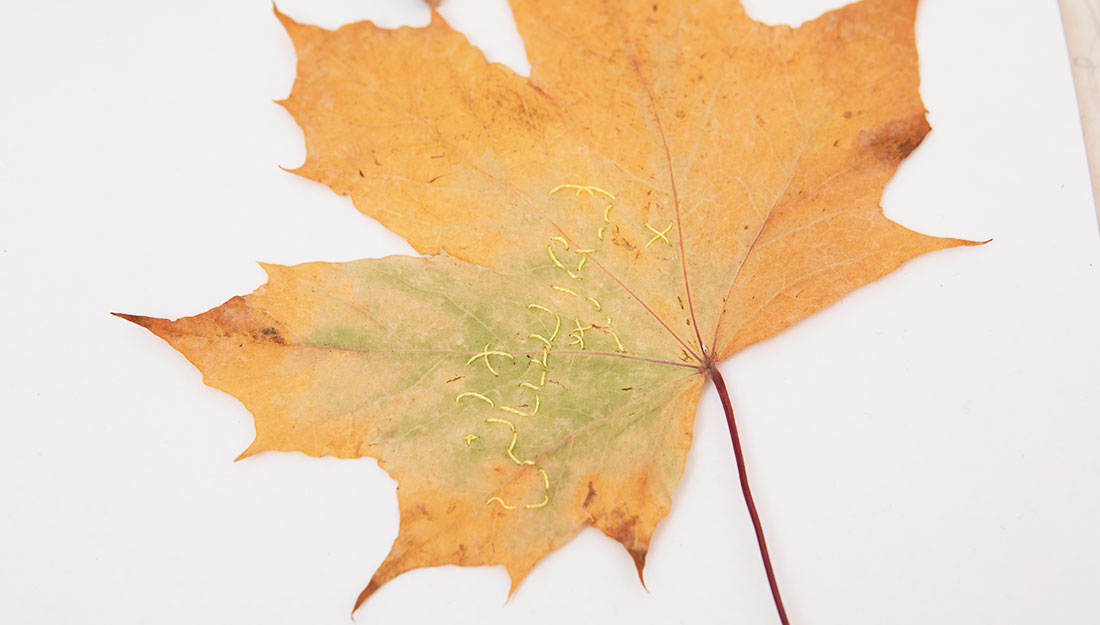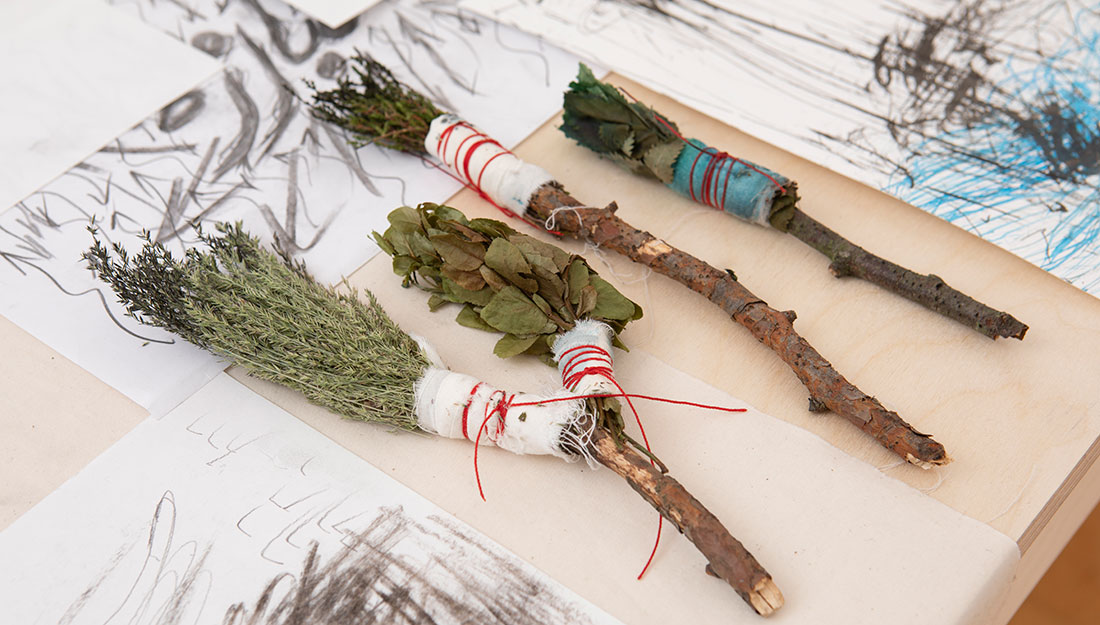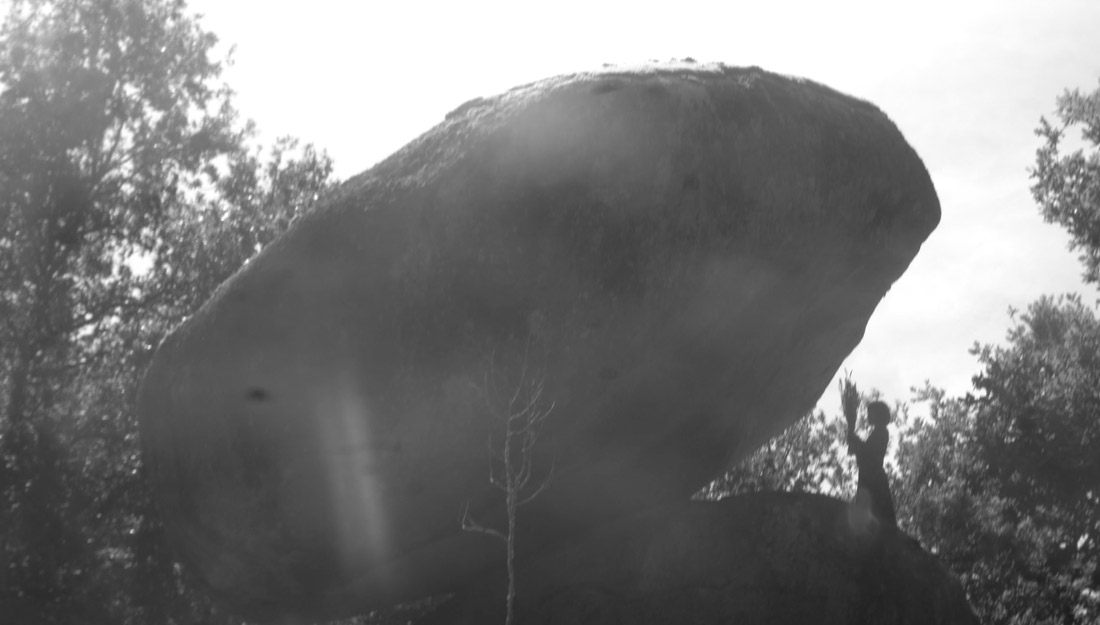
Gelawesh Waledkhani and Lise Bjørne Linnert in collaboration with undocumented migrants in Norway.
A room between the rooms (2020 – ongoing). Installation.
Photos: Dewi Tannatt Lloyd.
Since March 2020 groups of undocumented migrants have met around “drawing tables” in workshops arranged by Gelawesh Waledkhani and Lise Bjørne Linnert. Tables with digital screens were set up simultaneously in Oslo, Trondheim and Bergen.
Participants connected to share memories and stories. They drew memories of a room, exploring and expressing emotions through lines, self-portraits, embroidered words and symbols, with both personal and universal meaning. Simon Stranger, a well-known Norwegian author led workshops, sharing how to use words poetically to tell their stories.
They worked outside using natural materials each season had to offer. In spring brushes were made from twigs and leaves. In autumn they stitched on fallen leaves, mending them as an act of care and protest. Their treatment of leaves symbolised how they wished for undocumented migrants living in limbo to be seen and treated.
Visit the exhibition to see an installation of their ongoing project and read on to hear the stories of some of the collaborators.
The collaborator’s stories
Addis (born 1976)
Born in Eritrea, Addis grew up in Ethiopia. He arrived in Norway in 2007. Addis’ partner is from Ethiopia, they have four children together.
His partner has a permanent residency in Norway. Addis is politically active against Eritrea and is a strong opponent of the regime in the country. He says he risks persecution and torture if he returns.
Addis says that life is difficult; without rights he does not have the opportunity to support himself and his family. He is a very positive person and is active in the Ethiopian / Eritrean community in Norway.
Hiwot (born 1956)
Hiwot arrived in Norway in 2002 from Ethiopia. She has a large family there, many children and grandchildren. She has not seen them since she left. She stays in contact online and is very proud of them.
Hiwot is a Christian, her faith supports her when everything else is uncertain and difficult. She is a role model to many people, she rarely complains and often uses humor as a way to connect. Hiwot has moved between reception centres and staying with friends in Oslo for years. She is tired of living like this and is developing health problems; exhausted after many years in limbo. In 2020 she caught COVID-19. This was largely due to the bad management of the reception centre she was staying in. Several people became ill due to room sharing.
From her hospital bed, Hiwot was vocal. She made noise; speaking to the media, the story became national news. She hopes that a new law will pass. If successful the law will grant permanent residency to long term asylum seekers above the age of 65.

Hooshang (b 1975 )
Born in Iran Hooshang arrived in Norway in 2008. For many years he has been a strong critic of Iran’s Islamic regime. He has gone on hunger strike in front of the Parliament in Oslo, participated in numerous demonstrations and voiced his opinions on social media.
Amnesty International considers Hooshang to be a ‘prisoner of conscience’. His protests have not been without fear. He has been threatened and feels he is being watched by the regime in Iran. For over four years he lived in a tent in a forest in Norway. Sometimes he didn’t dare to sleep in the tent, so hid in the forest in case someone came to take him.
Hooshang was recently granted asylum after 13 years in Norway. He finally has access to Norwegian language classes, a crucial step to be able to get work in Norway.
Koroush (b 1961)
Koroush arrived in Norway from Iran more than 20 years ago. He converted to Christianity, and is an active member of a local church in Oslo. He spends much of his time as a volunteer at the Poor House*, where he distributes food and clothes.
He is a warm person; caring for the people around him. Koroush does not have his own family, but his sister and her two adult children also live in Norway. He moves around, like so many other undocumented migrants, from one friend’s house to another.
Koroush is also a regime critic and often participates in demonstrations outside the Iranian Embassy.
*The Poor House is a voluntary aid and interest organization in Norway, that aims to help people in difficult situations due to poverty through direct help. They distribute food, clothing and offer haircuts, physiotherapy and other support. The organization also undertakes political work to focus on the issue of poverty in Norway. The Poor House have minimal municipal and state support and daily operations are mainly thanks to donors. The volunteers consist of over 50 people from a variety of backgrounds who want to make the everyday lives of underprivileged people a little brighter.
Mansour (born 1981)
An activist and a regime critic Mansour arrived from Iran in 2003. He is active in the Iranian exile community in Oslo. He participates in demonstrations and criticism of the Iranian regime, on social media, regarding human rights violations.
In the autumn of 2020, Mansour finally received a temporary residence permit. This allows him to start the government’s introductory program and Norwegian training. Now permitted to work and open a bank account, Mansour is able to rent a small apartment in an area near Oslo. He is saving to apply for a family reunion permit to be with his wife and son again.
Meseret (born 1979)
Born in Ethiopia, Meseret arrived in Norway in 2008. During her years in Norway, she has moved several times between different asylum centres and friend’s homes. Meserat finds it difficult living in the centres, so she copes as best she can outside the system. Meseret is Oromo, which is why she applied for asylum in Norway.
According to OLF (Oromo Liberation Front), of which Meseret is a member, Oromo people are persecuted and oppressed in Ethiopia. Her father and uncle were also members of the OLF. Meseret has no family in her home country. She has been on the board of ‘People in Limbo’, an organisation that supports undocumented migrants, for several years. She is a strong and wise woman, who fights for humanism and improving the rights of all undocumented migrants in Norway.
Meseret is politically active; she participates in events, demonstrations and debates. She asks reflective and challenging questions to politicians and others within the system.
Meseret is a good friend who always looks after others. She has good humor, she doesn’t let dark thoughts define her life, instead she is constructive and fights for more humanity and warmth in Norway.

Mina, (born 1988)
Born in Iran, Mina went to Norway in 2015. Since then she has moved 11 times, between different cities and homes. Currently Mina lives in Trondheim, in a house she shares with 17 other people, women and children.
As she doesn’t have a permit to work or study she has little to occupy her time. So she volunteers with different organisations, working to fill her day with meaning. Mina has to leave her son in Iran and has not seen him in five years. She hopes to be granted asylum so that her son can join her.
Mina is living under a lot of stress, without any of rights other people have. She also feels looked down on. She is longing to participate, contribute to society and live as a normal person.
Monire (born 1979)
Monire was born in Afghanistan. She arrived in Norway five years ago, after a long fleeing journey with stops in five different countries. She fled with her husband and two daughters. Her husband left them in Greece and Monire traveled the rest of the journey alone with her children.
After arriving in Norway, the small family has had to move five times. Monire is a kind and quiet person, wanting the best for her daughters. She hopes for the permission to start a new life with them in Norway.
Nasim (born 1979)
Nasim was born in Iran, he went to Norway in 2007. In 2011 due to a change of government, a new law was passed which meant that people who had applied for asylum were no longer allowed to work while they waited for their application to be processed. This had a huge impact on the lives of many migrants.
Nasim lost his job and his apartment. Since then he has constantly had to move around, he has mainly lived with friends. He fights for change and has become a visible voice for undocumented migrants. He appears in interviews and works with lawyers to try to change the laws. Nasim has also been to the parliament and talked to politicians. He always tries to share the struggle the undocumented are having, with a focus on those that have been in Norway for many years.
Many people are afraid to talk about their situation, afraid to show their face, in case they are deported. Nasim volunteers for many organisations, including: the Red Cross, the Church City Mission, a health centre for undocumented migrants and, People in Limbo. He works as a cameraman and photographer for a political Kurdish TV channel. Since 2016, he has volunteered more than 2000 hours. In his spare time, finding a quiet place, Nasim likes to write poems.
Parwana (b 1985) and Sara (b 1988)
Sisters Parwana and Sara were born as refugees in a camp in Iraq. Originally, they were Kurdish from Iran. They have lived as displaced people all their lives. In November 2015 they arrived in Norway with their mother, father and younger brother.
In Norway, the family have been moved seven times: Oslo, Arendal, Mandal, Lillesand, Moi, Larvik, and now Trondheim where they live in a small house. The sisters have to share a room. Whilst in Norway they had access to 175 hours of Norwegian language classes, this has now ended. Sometimes they attend a language café or occasional Norwegian classes given by private individuals. They are eager to learn and keen to get on with their lives. Now they are mainly at home, occasionally going for walks. Their application for political asylum has been rejected twice. They are allowed to stay in the country while the case is processed again.
Parwana likes to write and writes poems for herself. Sara likes to take pictures and film. She does not like to talk about the past. It hurts.
Sara (b 1956)
Born in Ethiopia, Sara went to Norway in 2002. Since then she has lived in several asylum reception centres throughout the country. Now she lives with her partner, a Norwegian man, in Oslo.
Sara is one of the long-term undocumented migrants that might receive legal residency in Norway. A new law is pending that will grant permanent residency to long term unreturnable* asylum seekers above the age of 65.
Sara is a tough woman and has strong opinions that she is not afraid to voice. Several times Sara has be interviewed for newspapers, she is not afraid to talk to journalists. She has a large network and is an important and unifying person in the Ethiopian community in Oslo. Sara has children in her former home country that she stays in regular contact with. As an Oromo, she fights to improve their rights in Ethiopia. Although she has a fighting spirit, the years of waiting and hoping for residency has taken its toll on her. Now she hopes the new law will be passed.
*This term refers to an asylum seeker that has been rejected residency in Norway, but for different reasons they cannot be returned to their country of origin. This is either; because the country refuses to receive the person, or their country of origin cannot be verified. As a result, they are stuck in limbo; not given permission to stay and not being able to be returned.

Sirwan (born 1982)
Arriving in Norway in 2011, Sirwan was born in Iran. After receiving several rejections for his application for asylum, he took the Norwegian Directorate of Immigration (UDI) to court in 2015. He won. However, the government would only provide him a temporary one-year permit, saying that the political situation in Iran might change.
Every year Sirwan has to re-apply for his residency. Every year when he gets just another year’s permission to stay, he sends an objection. The UDI uses another year to look into his complaint. With a temporary permit, Sirwan can work and he pays taxes to the Norwegian state. Yet he doesn’t have the same rights as the other workers. H doesn’t get paid sick pay and he can’t use the free school system in Norway. If hewants to study, he has to go to private schools and pay himself.
Sirwan has a daughter that lives in a remote area in Norway. He wants to learn to drive so he can visit her regularly, but he is not allowed to learn. He has never done anything wrong and he wants to contribute fully to Norwegian society; he wants to live fully. Why are Norwegian authorities making him wait in limbo, year after year? When is long enough?
Tamru (born 1987)
Arriving in Norway in 2003, Tamru was born in Ethiopia. In the winter of 2019 Tamru was detained by the Immigration Board at Trandum for four months. During this time his girlfriend gave birth to his first child, he was not allowed to be present at the birth. He saw his newborn son for the first time two months later when he was released.
Tamru’s asylum application has been rejected several times. He is worried about being persecuted in his former home country due to political activity. He is still politically active in Norway.
Tigisti (b 1972)
Born in Ethiopia, Tigisti entered Norway in 2009. She is a quiet and cautious person who does not like to get too much attention but is both social and helpful. She is an active supporter of the organisation ‘Humans in Limbo’. Like for many other undocumented migrants in Norway without permit, learning the language is difficult. Without access to Norwegian language training and not being able to participate in Norwegian society like a normal citizen, the language is very hard to learn. However, Tigisti understands a lot.
Tigisti is tired; for 11 years she has had to move between various reception centres and friends. She now has health problems, which adds to her need to have a space of her own. As she is under 65, the proposed law for long term asylum seekers will not impact her case. She cannot return to Ethiopia. Tigisti is trapped in limbo.
Zahra (born 1983)
Arrived in Norway from Iran four years ago. When this project started, she lived in a reception centre outside Trondheim with her husband and two children, one baby and a toddler. Their application for asylum in Norway has been rejected twice.
In December the family were forced to move to another reception centre in a new city far from Trondheim. Zahra describes her life as lonely. She has a strong character and is an active participant in the workshops. She has always participated alone in the room where they stay. Her husband looks after the children during the session. The other participants have been able to take part online in groups of two or threes. Zahra has said how she would have loved to do the workshops with other people there with her.
The artists created a film of footage taken during the workshops.



